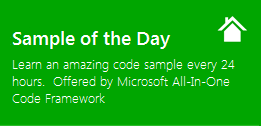[Sample of June 14th] Check UAC privilege level and self-elevate process in C++
 |  | |
 |  | |
Sample Download : https://code.msdn.microsoft.com/CppUACSelfElevation-5bfc52dd
User Account Control (UAC) is a new security component in Windows Vista and newer operating systems. With UAC fully enabled, interactive administrators normally run with least user privileges. This example demonstrates how to check the privilege level of the current process, and how to self-elevate the process by giving explicit consent with the Consent UI.


For detailed introduction of the sample, please read the documentation at https://code.msdn.microsoft.com/CppUACSelfElevation-5bfc52dd
 You can find more code samples that demonstrate the most typical programming scenarios by using Microsoft All-In-One Code Framework Sample Browser or Sample Browser Visual Studio extension. They give you the flexibility to search samples, download samples on demand, manage the downloaded samples in a centralized place, and automatically be notified about sample updates. If it is the first time that you hear about Microsoft All-In-One Code Framework, please watch the introduction video on Microsoft Showcase, or read the introduction on our homepage https://1code.codeplex.com/.
You can find more code samples that demonstrate the most typical programming scenarios by using Microsoft All-In-One Code Framework Sample Browser or Sample Browser Visual Studio extension. They give you the flexibility to search samples, download samples on demand, manage the downloaded samples in a centralized place, and automatically be notified about sample updates. If it is the first time that you hear about Microsoft All-In-One Code Framework, please watch the introduction video on Microsoft Showcase, or read the introduction on our homepage https://1code.codeplex.com/.
Comments
- Anonymous
June 18, 2012
This describes itself as being able to "self-elevate the process", however all it really does is to start another instance of itself (elevated) and then close down the current instance. i.e. it calls ShellExecuteEx with the "runas" verb.